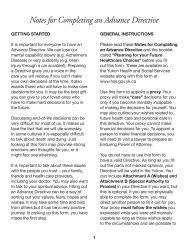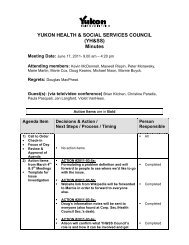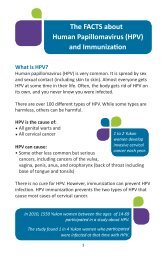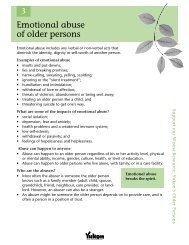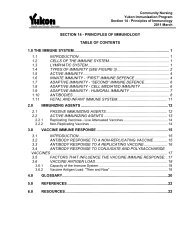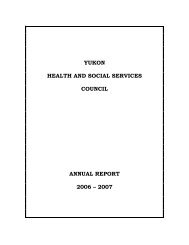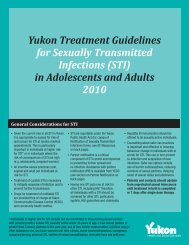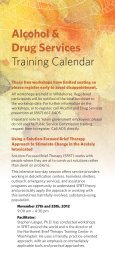West Nile Virus & Yukon
West Nile Virus & Yukon
West Nile Virus & Yukon
Create successful ePaper yourself
Turn your PDF publications into a flip-book with our unique Google optimized e-Paper software.
<strong>West</strong> <strong>Nile</strong> <strong>Virus</strong> & <strong>Yukon</strong><br />
• <strong>West</strong> <strong>Nile</strong> virus (WNV) has not been found in mosquitoes, mammals, birds or humans in<br />
<strong>Yukon</strong>.<br />
• As of June 2004, WNV had not been found in a jurisdiction bordering on <strong>Yukon</strong> however<br />
jurisdictions are preparing for the possibility that it will arrive this summer.<br />
• <strong>Yukon</strong> has the carriers (birds and mosquitoes) present to support WNV activity at some<br />
level.<br />
• One <strong>Yukon</strong> resident was diagnosed with WNV last summer but this individual contracted the<br />
disease in Saskatchewan.<br />
Travelling outside the <strong>Yukon</strong><br />
<br />
<br />
<strong>Yukon</strong>ers travelling at home or across the North, are at a low risk of being infected with<br />
WNV.<br />
However, travelling to southern Canada, the U.S., Mexico or the Caribbean, increases the<br />
risk of being infected. Travellers should take precautions to protect themselves and their<br />
families from mosquito bites. Protection tips are listed below.<br />
WNV infections<br />
• WNV is transmitted through mosquito bites to humans and animals.<br />
• Most people who become infected will experience no symptoms at all.<br />
• About 20% of those infected will develop symptoms, such as fever, headache and body aches<br />
lasting one week or less. Some persons will develop a rash.<br />
• In rare cases (less than 1%), WNV infection can result in serious health effects such as<br />
meningitis (inflammation of the lining of the brain), encephalitis (inflammation of the brain)<br />
or other serious disease of the central nervous system including polio-like paralysis.<br />
The origin and spread of WNV<br />
• WNV was first identified in Uganda in 1937 and was historically found in parts of Southern<br />
Europe, the Middle East, Africa and Asia.<br />
• Since its discovery in North America in New York in 1999, WNV has moved rapidly north<br />
into Canada and south as far as Florida. WNV has also moved steadily west across the<br />
continent to the <strong>West</strong> Coast of the United States.<br />
• It has spread to nearly all 48 continental US states, and seven Canadian provinces.<br />
WNV and the very wide range of animal species<br />
• In nature, WNV exists in a cycle passing between birds and mosquitoes.<br />
• Many bird species can be infected with WNV, but members of the crow family, known as<br />
corvids (ravens, magpies and jays) have a relatively high death rate when infected and are<br />
often the earliest to show infection.
• For this reason, testing samples of dead corvids for WNV is an effective way of determining<br />
when the virus is active in an area.<br />
If you find A dead bird<br />
You can play an important role in monitoring for WNV by reporting dead birds to your nearest<br />
Environment <strong>Yukon</strong> office. Dead birds may be an indicator that the virus is in an area, but birds<br />
also die from other causes such as starvation, old age or food poisoning.<br />
• Do not pick up the birds unless you are familiar with safety precautions. Please call your<br />
nearest Environment <strong>Yukon</strong> office. Environment <strong>Yukon</strong> Conservation Officers and Regional<br />
Biologists have specific instructions on how to handle dead birds. It is best to assume that<br />
any specimen could be infectious and to take proper precautions at all times.<br />
Personal Prevention Measures<br />
1. Minimize your exposure to mosquitoes:<br />
• When going outdoors, use insect repellents that contain DEET or other approved ingredients.<br />
• Try to avoid spending time outdoors at dawn and at dusk when mosquitoes are most active.<br />
• Wear protective clothing such as long-sleeved shirts, long pants and a hat. Light coloured<br />
clothing is best because mosquitoes tend to be more attracted to dark colours.<br />
• Make sure that door and window screens fit tightly and have no holes that may allow<br />
mosquitoes indoors.<br />
2. Eliminate mosquito breeding sites around your home and cabin:<br />
Mosquitoes lay eggs in standing water and it takes about four days for the eggs to grow into<br />
adults that are ready to fly. Even a small amount of water, for example, in a saucer under a<br />
flowerpot, is enough to act as a breeding ground. Therefore, it is important to eliminate as much<br />
standing water around your property as possible by:<br />
• Regularly draining standing water from items like pool covers, saucers under flowerpots,<br />
recycle bins, garbage cans etc.<br />
• Remove any unused items from around your property including old tires that have a tendency<br />
to collect water.<br />
• Change the water in wading pools, bird baths, pet bowls and livestock watering tanks twice a<br />
week.<br />
• Cover rain barrels with screens.<br />
• Clean out eaves troughs regularly to prevent clogs that can trap water.<br />
• If you have an ornamental pond, consider getting fish that will eat mosquito larvae.<br />
A Word About DEET<br />
The most effective repellents contain DEET (N,N-diethyl-m-toluamide), which is an ingredient<br />
used to repel pests like mosquitoes and ticks. DEET has been tested against a variety of biting<br />
insects and has been very effective. The more DEET a repellent contains the longer time it can<br />
protect you from mosquito bites. A higher percentage of DEET in a repellent does not mean that<br />
your protection is better—just that it will last longer. DEET concentrations higher than 50% do<br />
not increase the length of protection.
DEET is the most effective and best-studied insect repellent available. Studies using humans and<br />
mosquitoes report that only products containing DEET offer long-lasting protection after a single<br />
application.<br />
Products containing DEET are very safe when used according to the directions. Because DEET<br />
is so widely used, a great deal of testing has been done. Over the long history of DEET use, very<br />
few confirmed incidents of toxic reactions to DEET have occurred when the product is used<br />
properly.<br />
You can use insect repellent and sunscreen together. Apply the sunscreen first, and then the<br />
insect repellent.<br />
DEET and children<br />
No definitive studies exist in the scientific literature about what concentration of DEET is safe<br />
for children. In the United States, the Centers for Disease Control and Prevention note that no<br />
serious illness has arisen from use of DEET when used according the manufacturer’s<br />
recommendations.<br />
Current labels on insect repellents containing DEET state that these products are not to be used<br />
on children under the age of 2 years (infants or toddlers). It is now recommended, in light of the<br />
PMRA's re-evaluation of DEET, which included input from the Canadian Paediatric Society,<br />
that:<br />
On children under six months of age<br />
• insect repellents containing DEET still not be used<br />
On children aged six months to 2 years<br />
• the use of 1 application per day may be considered in situations where a high risk of<br />
complications from insect bites exist<br />
• the product be applied sparingly and not be applied to the face and hands;<br />
• only the least concentrated product (10% DEET or less) should be used<br />
• prolonged use be avoided<br />
On children between 2-12 years of age<br />
• the least concentrated product (10% DEET or less) be used and that it be applied no more<br />
than 3 times per day.<br />
Parents should choose the type and concentration of repellent to be used by taking into account<br />
the amount of time that a child would be outdoors, exposure to mosquitoes, and the risk of<br />
mosquito-transmitted disease in the area. Persons who are concerned about using DEET or other<br />
products on children may wish to consult their health care provider for advice.


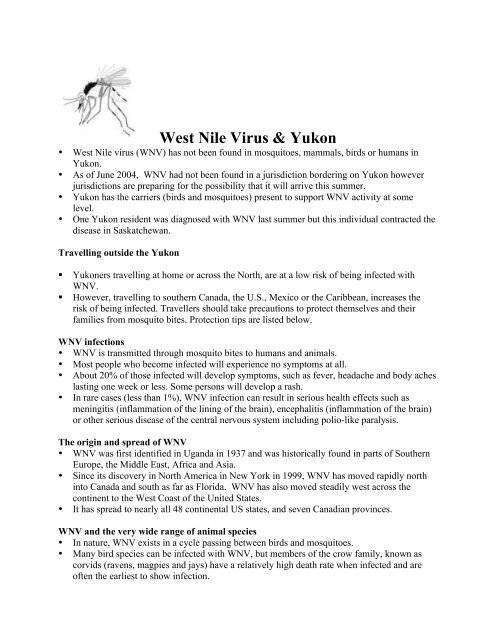
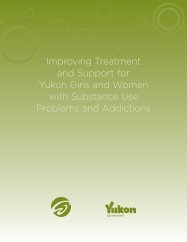
![Women and Alcohol: A women's health resource [2326.26 KB ]](https://img.yumpu.com/22340649/1/190x245/women-and-alcohol-a-womens-health-resource-232626-kb-.jpg?quality=85)
